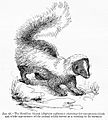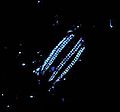Animal colour facts for kids
Animal colour is how animals get their amazing looks! It's all about how light bounces off their bodies. Animals create colours in different ways. Some use special chemicals called pigments. Others have tiny cells called chromatophores that can change colour. Some even glow in the dark using bioluminescence!
Colour is super important for animals because most animals rely on their sight. Predators use sight to find their food, and prey use it to spot danger. So, an animal's colour helps it do important things like finding food, hiding from enemies, or even finding a partner. Because colour helps animals survive and have babies, it's shaped by something called natural selection.
Contents
Why Animals Have Different Colours
Animal colours serve many important purposes. These functions help animals survive and thrive in their environments.
Hiding and Blending In
- Camouflage: This helps an animal stay hidden from others. It might blend in with its surroundings, making it hard for predators or prey to see it. Think of a chameleon changing its skin to match a leaf!
Sending Signals to Other Animals
- Warning colouration: Some animals have bright, bold colours to tell others, "Don't attack me! I'm dangerous or taste bad!"
- Mimicry: This is when one animal copies the warning colours of another dangerous animal. It's like a harmless animal pretending to be a dangerous one to scare off predators.
- Sexual selection: Animals often use bright colours or fancy patterns to attract a mate. The flashier they are, the more likely they are to find a partner.
- Other signals: Animals can use colour to show they are ready to clean parasites off other animals, like cleaner fish.
Tricking or Confusing Enemies
- Startle defence: Imagine an animal that suddenly flashes a bright colour or a big "eye-spot" when a predator gets too close. This sudden surprise can make the predator blink or hesitate, giving the prey a chance to escape.
- Dazzle: Some animals, like zebras, have bold patterns. When they move quickly, these patterns can confuse a predator, making it hard to pick out a single animal to chase.
Protecting the Body
- Physical protection: Sometimes, colour helps protect an animal's body. For example, people living in sunny, tropical places often have dark skin. This dark pigment helps protect them from sunburn and skin cancer.
Accidental Colours
- Incidental colouration: Sometimes, an animal's colour isn't for a special purpose. For instance, our blood is red because of a chemical called haem, which carries oxygen. If this red shows on the surface, like our lips, it might then be used for signalling.
Most of the time, animal colour is about the relationship between predators and prey. Animals have developed many ways to protect themselves from being eaten, and colour is a big part of that!
How Colours Evolved
Scientists have been interested in animal colour for a long time. Charles Darwin, a famous scientist, wrote about natural selection in 1859. He suggested that features like colour helped individual animals have more babies. For example, if an animal had slightly better camouflage than others, it would be more likely to survive and pass on its genes.
Startle and Dazzle Defences
Animals often use camouflage to hide from far away. But what happens when a predator gets really close? That's when they might use a "flash" defence. This is called deimatic defence, which means "to frighten" in Greek.
When a predator gets too close, the prey might suddenly show a bright colour or a big "eye-spot." This can make the predator blink or turn away for a second. That tiny moment is all the prey needs to fly or jump away and hide again. This mix of colour and behaviour is quite common in nature.
See Also
 In Spanish: Coloración animal para niños
In Spanish: Coloración animal para niños
Images for kids
-
An oriental sweetlips fish waits while two Cleaner fish pick parasites from its skin.
-
A peacock butterfly shows its amazing eye-spots when its wings are open.
-
Robert Hooke's Micrographia
-
The warning colours of a skunk from a book by Edward Bagnall Poulton.
-
A flower mantis uses aggressive mimicry to look like a flower and catch prey.
-
A cleaner wrasse signals its cleaning services to a big eye squirrelfish.
-
A venomous coral snake uses bright colours to warn off predators.
-
The hawk-cuckoo looks like a predatory shikra, helping it lay eggs unnoticed.
-
A praying mantis shows off bright colours to startle predators.
-
The olm looks pink because of its blood.
-
This shows how chromatophores (dark spots) on a zebrafish change in dark or light conditions.
-
The red pigment in a flamingo's feathers comes from its diet of shrimps.
-
Squid chromatophores appear as different coloured spots in this close-up.
-
The brilliant colours of a peacock's tail are created by Structural coloration.
-
A Euplokamis comb jelly glows in the dark using bioluminescence.


























